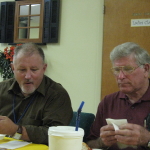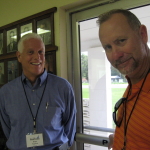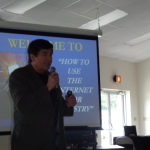With the recent admission by the United States Department of Defense that remarkable videos captured by US Navy F-18s purporting to show UAVs—Unidentified Aerial Vehicles, the modern term for UFOs—are genuine, we’re going to devote several articles to putting this subject in context. You may be surprised to learn that the modern UFO is just a sci-fi veneer on a very old phenomenon.
It’s not extraterrestrial, it’s interdimensional.
Humans have wondered about the stars since forever. That’s understandable; they’re beautiful and mysterious, as out of reach as mountain peaks. And perhaps for the same reasons, the earliest speculation about the stars revolved around gods, not extraterrestrials.
As with mountains, humans have associated stars with deities since the beginning of human history. Three of the most important gods in the ancient Near East, from Sumer to Israel and its neighbors, were the sun, moon, and the planet Venus. To the Sumerians they were the deities Utu, Nanna, and the goddess Inanna; later, in Babylon, they were Shamash, Sîn, and Ishtar. The Amorites worshiped Sapash, Yarikh, and Astarte.
Yahweh not only recognized that the nations worshiped these small-G gods, He allotted the nations to them as their inheritance—punishment for the Tower of Babel incident.
When the Most High gave to the nations their inheritance, when he divided mankind, he fixed the borders of the peoples according to the number of the sons of God. (Deuteronomy 32:8)
And beware lest you raise your eyes to heaven, and when you see the sun and the moon and the stars, all the host of heaven, you be drawn away and bow down to them and serve them, things that the LORD your God has allotted to all the peoples under the whole heaven. (Deuteronomy 4:19)
In other words, God placed the nations of the world under small-G “gods” represented by the sun, moon, and stars, but He reserved Israel for Himself. The descendants of Abraham, Isaac, and Jacob were to remain faithful to Yahweh alone, and through Israel He would bring forth a Savior.
But the gods Yahweh allotted to the nations went rogue. That earned them a death sentence.
God has taken his place in the divine council;
in the midst of the gods he holds judgment:
“How long will you judge unjustly and show partiality to the wicked? Selah […]
I said, “You are gods, sons of the Most High, all of you; nevertheless, like men you shall die,
and fall like any prince.” (Psalm 82:1-2, 6-7)
To be absolutely clear, those small-G gods are not to be confused with capital-G God, Yahweh, Creator of all things including those “sons of the Most High.” We know the consensus view among Christians is to treat the gods of Psalm 82 as humans, usually described as corrupt Israelite kings or judges. With all due respect to the scholars who’ve held that view over the centuries, it’s wrong. First, the Hebrew word elohim (“gods”) always refers to spirit beings, and verse 7—“nevertheless, like men you shall die”—makes no sense if God was addressing a human audience.
Humanity has looked to the stars as gods for at least the last 5,000 years. End times prophecy, from the perspective of pagans, is about the return of the old gods, spirits defined as rebel angels and demons by the Hebrew prophets and apostles.
The Infernal Council has been playing a very long game. Once upon a time, Christians generally held a biblical worldview. The influence of the spirit realm on our lives wasn’t perfectly understood, but at least it was acknowledged. And while the church of Rome can be fairly criticized for keeping the Bible out of the hands of lay people for nearly a thousand years, at least the learned scholars and theologians of the church made a fair effort to interpret their world through a biblical filter.
In our modern, enlightened age, however, the principalities and powers have nudged and prodded humanity through the Enlightenment and Modernism into Postmodernism, shifting us from a supernatural worldview to one that only accepts an external creator in the form of “ancient aliens,” which allows us to account for the supernatural while simultaneously denying the existence of God.
In 1973, science fiction author Arthur C. Clarke wrote, “Any sufficiently advanced technology is indistinguishable from magic.” By substituting advanced science for the supernatural, ancient aliens evangelists have created a godless religion perfect for the 21st century. It offers mystery, transcendence, and answers to the big questions: Where do we come from, why are we here, and where do we go when we die?
Best of all, believers in ET don’t need to change the way they think or act, except maybe to promise to our benevolent space brothers that we’ll live peacefully with our galactic neighbors. And, as surprising as it may seem, the followers of Eric von Däniken and Zecaria Sitchin aren’t the first to concoct a religion that includes a belief in extraterrestrial life.
Consider, for example, Emanuel Swedenborg, an 18th century Swedish scientist, philosopher, and mystic. He was undoubtedly brilliant, but sometimes the brilliant are blinded by their own light. His theology encompassed the following concepts:
- The Bible is the Word of God; however, its true meaning differs greatly from its obvious meaning. Furthermore, he and only he, through the help of angels, could discern the true meaning and message of the Scriptures.
- Swedenborg believed that the world of matter is a laboratory for the soul, where the material is used to “force-refine” the spiritual.
- In many ways, Swedenborg was quite universal in his concepts, for he believed that all religious systems have their divine duty and purpose and that this is not the sole virtue of Christianity.
- Swedenborg believed that the mission of the Church is absolutely necessary inasmuch as, left to its own devices, humanity cannot work out its relationship to God.
- He saw the real power of Christ’s life in the example it gave to others and rejected the concept of atonement and original sin.
Swedenborg believed he heard directly from angels who lived elsewhere in the solar system. To this day, the Swedenborg Foundation offers a modern translation of the mystic’s 1758 work Life on Other Planets, a book that “details Swedenborg’s conversations with spirits from Jupiter, Mars, Mercury, Saturn, Venus, and the moon, who discuss their lives on other planets and how their cultures differed from those of earthly life.” Swedenborg’s teachings on spiritism and angelic ETIs and those who believe them are still around, although they’ve rebranded the faith as The New Church. (Maybe “Swedenborgianism” didn’t test well in focus groups.) It’s a small sect, about 10,000 adherents worldwide, but the point is this: The messages Swedenborg received are very much like the telepathic contact some claim to receive from ETIs today—and similar to messages whispered into the minds of the demonically oppressed and possessed.
Of course, Swedenborg, who died in 1772, wasn’t the last word in the rise of mystic scientism. Joseph Smith, who founded Mormonism about fifty years after Swedenborg’s death, incorporated belief in the existence of many worlds in the doctrines of the Church of Latter Day Saints. Smith taught that God was flesh and blood, formerly a mortal man who’d earned godhood and, apparently, the right to create multiple earths.
Book of Moses Chapter One-Joseph Smith
29 And [Moses] beheld many lands; and each land was called earth, and there were inhabitants on the face thereof.
30 And it came to pass that Moses called upon God, saying: Tell me, I pray thee, why these things are so, and by what thou madest them?
31 And behold, the glory of the Lord was upon Moses, so that Moses stood in the presence of God, and talked with him face to face. And the Lord God said unto Moses: For mine own purpose have I made these things. Here is wisdom and it remaineth in me.
32 And by the word of my power, have I created them, which is mine Only Begotten Son, who is full of grace and truth.
33 And worlds without number have I created; and I also created them for mine own purpose; and by the Son I created them, which is mine Only Begotten.
34 And the first man of all men have I called Adam, which is many.
Mormonism was just one among the waves of new spiritual movements that washed across the United States in the 19th century. Beginning with the Second Great Awakening in the 1790s, a reaction to the rationalism and deism of the Enlightenment, a series of revivals, cults, and camp meetings followed European settlers westward as the country grew and prospered. The raw, unspoiled nature of the frontier contributed to a desire to restore Christianity to a purer form, free from the formality and hierarchy of the churches of Europe.
The Second Great Awakening, which swelled the numbers of Baptists and Methodists especially, peaked by the middle of the 19th century, but other spiritual movements followed close behind. And here’s where the Venn diagram begins to overlap ancient cults of the dead and a modern “scientific” worldview.
The spiritualist movement, which emerged from the same region of western New York state that produced Joseph Smith, the so-called Burned-over District, first appeared in the late 1840s. Sisters Kate and Margaret Fox, ages 12 and 15, claimed to communicate with spirits of the dead through coded knocks or “rappings.” They either convinced their 17-year-old sister, Leah, or brought her in on the gag, and she took charge of the younger two, managing their careers for years.
The Fox sisters not only enjoyed long careers as mediums, they left a legacy that continues to this day in the work of television mediums like John Edward, Theresa Caputo, and Tyler Henry—despite the fact that Margaret and Kate admitted in 1888 that they’d invented the whole thing:
“That I have been chiefly instrumental in perpetrating the fraud of Spiritualism upon a too-confiding public, most of you doubtless know. The greatest sorrow in my life has been that this is true, and though it has come late in my day, I am now prepared to tell the truth, the whole truth, and nothing but the truth, so help me God! . . I am here tonight as one of the founders of Spiritualism to denounce it as an absolute falsehood from beginning to end, as the flimsiest of superstitions, the most wicked blasphemy known to the world.”
The Fox sisters used a variety of techniques, one of which was simply cracking their toe joints, to produce the sounds that fooled gullible audiences into believing that spirits answered their questions. But even after their confession was published by a New York City newspaper, the spiritualist movement never skipped a beat. To this day, “many accounts of the Fox sisters leave out their confession of fraud and present the rappings as genuine manifestations of the spirit world.”
Isn’t that remarkable? Humans are so desperate for contact with the dead that the spiritualist movement lives on into our enlightened age even though its founders admitted their act was as real as professional wrestling. Well-known believers have included such powerful intellects as Sir Arthur Conan Doyle, the creator of Sherlock Holmes.
In fact, Conan Doyle wrote The History of Spiritualism in 1926, and he pegged March 31, 1848—the very first time Kate and Margaret Fox claimed to hear from spirits—as the date the movement began.
Next Month: Blavatsky, Crowley, and Lovecraft.

Derek Gilbert Bio
Derek P. Gilbert hosts SkyWatchTV, a Christian television program that airs on several national networks, the long-running interview podcast A View from the Bunker, and co-hosts SciFriday, a weekly television program that analyzes science news with his wife, author Sharon K. Gilbert.
Before joining SkyWatchTV in 2015, his secular broadcasting career spanned more than 25 years with stops at radio stations in Philadelphia, Saint Louis, Little Rock, and suburban Chicago.
Derek is a Christian, a husband and a father. He’s been a regular speaker at Bible prophecy conferences in recent years. Derek’s most recent book is The Great Inception: Satan’s PSYOPs from Eden to Armageddon. He has also published the novels The God Conspiracy and Iron Dragons, and he’s a contributing author to the nonfiction anthologies God’s Ghostbusters, Blood on the Altar, I Predict: What 12 Global Experts Believe You Will See by 2025, and When Once We Were a Nation.












